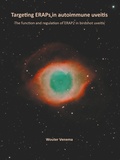Targeting ERAPs in autoimmune uveitis

Venema, Wouter
- Promoter:
- Prof.dr. J.H. (Joke) de Boer
- Co-promoter:
- Dr. J.J.W. (Jonas) Kuiper & dr. J. (Jeanette) Ossewaarde-van Norel
- Research group:
- Boer Kuiper
- Date:
- November 21, 2023
- Time:
- 12:15 h
Summary
In this thesis, we aim to better understand how the genetic predisposition of ERAPs and MHC-I contributes to autoimmunity. These endoplasmic reticulum aminopeptidases (ERAPs) are involved in trimming peptides before these peptides are loaded on MHC-I. Therefore ERAPs are indirectly involved in which peptides might be presented to CD8+ T cells. Using birdshot uveitis (BU) as a prototypic MHC-I associated autoimmunity model, we examine how ERAP2 influences the composition of HLA-A*29-presented peptides in patient-derived cell lines. BU is the only disease known where all patients carry at least one HLA-A*29 allele. This makes BU an interesting disease model to study how ERAPs are facilitating peptide abundances for the disease associated HLA-A*29 MHC-I molecule.
We show that the effects of ERAP2 on the N-terminus of ligands of HLA-A*29 are shared across endogenous HLA allotypes, but discover and replicate that one peptide motif generated in the presence of ERAP2 is specifically bound by HLA-A*29. Further, we demonstrate how the amino acid structure of HLA-A*29 affects peptide binding capacity and discuss how ERAP1 and ERAP2 contribute to the immunopeptidome of HLA-A*29. We show evidence for internal sequence specificity for ERAP2 imprinted in the immunopeptidome. These results reveal that ERAP2 can generate an HLA-A*29-specific antigen repertoire, which supports that antigen presentation is a key disease pathway in BU.
Furthermore, we examined whether HLA-A*29 can present peptides derived from the candidate autoantigen retinal S-antigen and assess whether CD8+ T cells of patients recognize these peptides as immunogenic epitopes. We show the presence of naturally presented antigenic SAG peptides identified by sequencing the HLA-A*29 immunopeptidome of antigen-presenting cells of patients. In addition, we show that the N-terminally extended SAG peptide precursors can be trimmed in vitro by ERAP1 and ERAP2. Unexpectedly, no enhanced antigen engagement by CD8+ T cells upon stimulation with SAG peptides was observed in patients or HLA-A*29-positive controls. Multiplexed HLA-A*29-peptide dextramer profiling of a case-control cohort revealed that CD8+ T cells specific for these SAG peptides were neither detectable in peripheral blood nor in eye biopsies of patients. These findings demonstrate that SAG is not a CD8+ T cell auto-antigen and sharply contrast the paradigm in the pathogenesis of BCR.
Through CRISPR-Cas9-mediated gene editing, conformational capture assays, and conditional analysis of ERAP2 eQTL datasets, we uncover how multiple SNPs work in concert to regulate ERAP2 expression. We demonstrate by reciprocal allelic replacement that ERAP2 expression is directly controlled by the genotype of splice region SNP rs2248374. However, we demonstrate that autoimmune disease-risk SNPs located near the downstream LNPEP gene promoter are independently associated with ERAP2 expression. Allele-specific conformation capture assays revealed long-range chromatin contacts between the LNPEP promoter region and the ERAP2 promoter and showed that interactions were stronger in patients carrying the alleles that increase susceptibility to autoimmune diseases. Replacing the disease-associated SNPs in the LNPEP promoter by reference sequences lowered ERAP2 expression. These findings show that clustered GWAS signals associated with diverse autoimmune conditions and lethal infections act in concert to control ERAP2 expression and that disease-associated variants can convert a gene promoter region into a potent enhancer of a distal gene.